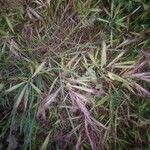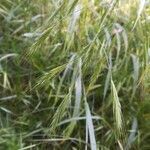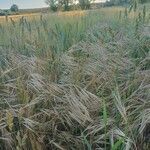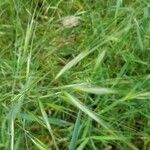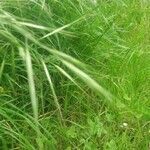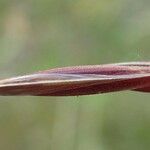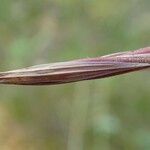Annual, caespitose. Culms 35–69 cm high. Leaves: basal sheaths puberulous to pilose (often sparsely so); blade 7–22 cm long, 2–6 mm wide, puberulous to pilose. Panicles nodding, open to contracted, 6.5–16 cm long; primary branches slightly spreading initially but becoming divaricate or reflexed. Spikelets spreading to pendulous, obovate, 27–35 mm long, with 6 bisexual florets; pedicel 5–60 mm long. Glumes subequal, apically keeled to dorsally rounded; lower glume 15.75–21 mm long, 1 (–3)-nerved with lateral nerves sometimes obscure, with midnerve apically papillose to scabrous and intercostal regions glabrous or sparsely puberulous; upper glume 22–31 mm long, 3 or 5-nerved, with midnerve apically scabrous and intercostal regions glabrous. Callus pointed, glabrous to scabrous or puberulous. Lemma 17–30 mm long, apically keeled, 7-nerved, scabrous; awn subapical, 36–60 mm long, straight, entered by 3 nerves. Palea slightly shorter than lemma, glabrous or minutely papillose or scabrous to sparsely puberulous. Anthers 0.75–3.5 mm long.
Annual; culms 35–80 cm. high, erect or spreading.. Leaf-blades 10–25 cm. long and 4–8 mm. wide; sheaths loosely hairy.. Panicles loose or somewhat contracted, up to 25 cm. long but variable in size and bearing few to many spikelets, nodding.. Spikelets loosely 5–8-flowered, oblong to wedge-shaped, 3–5 cm. long; glumes finely pointed, the lower subulate, 15–23 mm. long, 1–3-nerved, the upper narrowly lanceolate, 20–32 mm. long, 3–5-nerved; lemmas narrowly lanceolate in side view, 22–36 mm. long, herbaceous with hyaline margins, 7-nerved, scabrid, acuminately bilobed, awned from 4–7 mm. below the tip; awn 3.5–6 cm. long, straight, scabrid; callus oblong, ± 1 mm. long, obtuse; palea shorter than the lemma, sparsely and stiffly ciliate on the keels; anthers 2–3, 0.8–1.5 mm. long.
Loosely tufted annual, 0.3-1.1 m high; basal sheaths split. Leaf blade 50-400 x 3-8 mm, hairy; ligule an unfringed membrane. Inflorescence usually an open panicle; culm hairy below inflorescence; pedicels glabrous, scabrid or villous. Spikelet 30-90 x 3-8 mm (including awns), wedge-shaped, moderately laterally compressed; glumes unequal, shorter than spikelet; lower glume 1-nerved, upper 3-nerved. Florets 5-many; lemma 12-22 mm long, back rounded, apex acute, distinctly lobed; awn 30-70 mm long, stiff, straight; palea keels ciliate; ovary with a conspicuous hairy appendage at apex; anther 0.8-1.6 mm long. Flowering time Sept.-Jan., occasionally in Mar.
Loosely tufted annual 300-1100 mm high. Leaf blade 50-400 x 3-8 mm, hairy. Inflorescence usually open, branches stiff, erect or spreading; culm hairy below inflorescence; pedicels glabrous, scabrid or hairy. Spikelet 30-90 x 3-8 mm (including awns), open, wedge shaped, moderately laterally compressed; glumes unequal; lower glume 1-3-nerved, upper 3-5-nerved; lemma 12-22(35) mm long, rounded on back, apex distinctly bifid, acuminate; awn 30-70 mm long, stiff, straight, arising 1.5 mm or more below apex; palea keels ciliate; callus scar circular; anthers 0.8-1.6 mm long.
Annual; up to 1.1 m high; loosely tufted. Leaf blades 50-400 x 3-8 mm. Flowers: panicle usually lax and spreading; pedicels glabrous; scabrid or villous; spikelets 30-90 x 3-8 mm (including awns); spikelets open; wedge-shaped; lower glume 1-nerved; upper 3-nerved; lemmas 12-22 mm long; awns stiff and straight; 30-70 mm long; anthers 0.8-1.6 mm long.
Annual to 1 m. Leaves linear, hairy. Spikelets in a lax panicle, 30-90 mm long, lower glume 1-nerved, upper glume 3-nerved, lemma awn stiff and straight, 30-70 mm long.
A grass.
